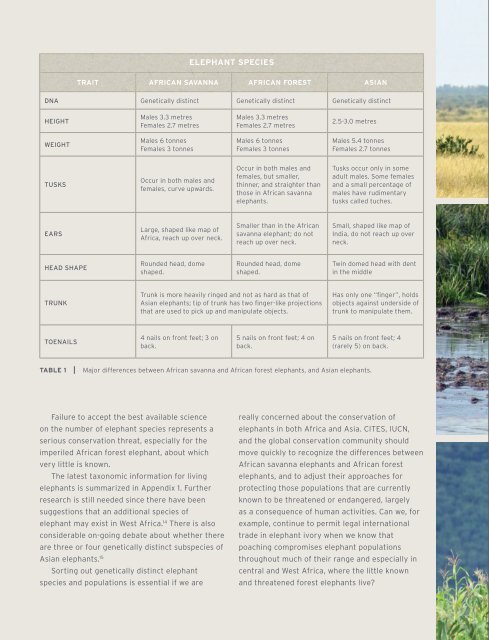ELEPHANTS & IVORY
ELEPHANTS & IVORY
ELEPHANTS & IVORY
Create successful ePaper yourself
Turn your PDF publications into a flip-book with our unique Google optimized e-Paper software.
ELEPHANT SPECIES<br />
TRAIT AFRICAN SAVANNA AFRICAN FOREST ASIAN<br />
DNA Genetically distinct Genetically distinct Genetically distinct<br />
HEIGHT<br />
WEIGHT<br />
TUSKS<br />
EARS<br />
HEAD SHAPE<br />
TRUNK<br />
TOENAILS<br />
Males 3.3 metres<br />
Females 2.7 metres<br />
Males 6 tonnes<br />
Females 3 tonnes<br />
Occur in both males and<br />
females, curve upwards.<br />
Large, shaped like map of<br />
Africa, reach up over neck.<br />
Rounded head, dome<br />
shaped.<br />
Males 3.3 metres<br />
Females 2.7 metres<br />
Males 6 tonnes<br />
Females 3 tonnes<br />
Occur in both males and<br />
females, but smaller,<br />
thinner, and straighter than<br />
those in African savanna<br />
elephants.<br />
Smaller than in the African<br />
savanna elephant; do not<br />
reach up over neck.<br />
Rounded head, dome<br />
shaped.<br />
Trunk is more heavily ringed and not as hard as that of<br />
Asian elephants; tip of trunk has two finger-like projections<br />
that are used to pick up and manipulate objects.<br />
4 nails on front feet; 3 on<br />
back.<br />
5 nails on front feet; 4 on<br />
back.<br />
2.5-3.0 metres<br />
Males 5.4 tonnes<br />
Females 2.7 tonnes<br />
Tusks occur only in some<br />
adult males. Some females<br />
and a small percentage of<br />
males have rudimentary<br />
tusks called tuches.<br />
Small, shaped like map of<br />
India, do not reach up over<br />
neck.<br />
Twin domed head with dent<br />
in the middle<br />
Has only one “finger”, holds<br />
objects against underside of<br />
trunk to manipulate them.<br />
5 nails on front feet; 4<br />
(rarely 5) on back.<br />
TABLE 1 | Major differences between African savanna and African forest elephants, and Asian elephants.<br />
Failure to accept the best available science<br />
on the number of elephant species represents a<br />
serious conservation threat, especially for the<br />
imperiled African forest elephant, about which<br />
very little is known.<br />
The latest taxonomic information for living<br />
elephants is summarized in Appendix 1. Further<br />
research is still needed since there have been<br />
suggestions that an additional species of<br />
elephant may exist in West Africa. 14 There is also<br />
considerable on-going debate about whether there<br />
are three or four genetically distinct subspecies of<br />
Asian elephants. 15<br />
Sorting out genetically distinct elephant<br />
species and populations is essential if we are<br />
really concerned about the conservation of<br />
elephants in both Africa and Asia. CITES, IUCN,<br />
and the global conservation community should<br />
move quickly to recognize the differences between<br />
African savanna elephants and African forest<br />
elephants, and to adjust their approaches for<br />
protecting those populations that are currently<br />
known to be threatened or endangered, largely<br />
as a consequence of human activities. Can we, for<br />
example, continue to permit legal international<br />
trade in elephant ivory when we know that<br />
poaching compromises elephant populations<br />
throughout much of their range and especially in<br />
central and West Africa, where the little known<br />
and threatened forest elephants live?<br />
AFRICAN SAVANNA ELEPHANT<br />
© IFAW/D. Willetts/Tsavo East National Park, Kenya<br />
FOREST ELEPHANT<br />
© IFAW/MDDEFE/Odzala-Kokoua, Republic of the Congo<br />
ASIAN ELEPHANT<br />
© IFAW/C. Dafan/Nuo Zhadu, Pu’er, Yunnan province, China<br />
27


